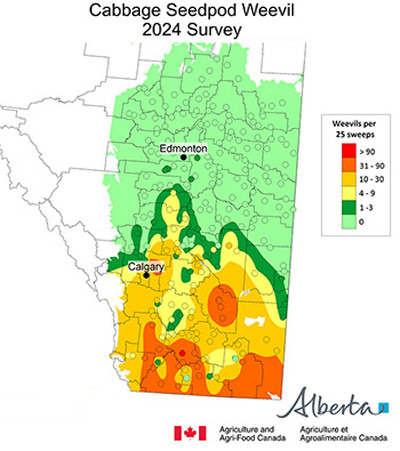This is not a forecast. It is a summary of the situation in Alberta in the summer of 2024.
Methodology
The 2024 survey covered the canola growing areas of southern and central Alberta. 222 fields in 50 municipalities were sampled in late June to early July when canola was at 20 to 25% flower. Surveyors sample by taking 25, 180 degree sweeps through the crop starting at the field edge and walking toward the centre of the field.
2024 survey findings
The survey found cabbage seedpod weevil at or below economic levels in southern Alberta with the exception of a couple of hotspots. There could have over threshold, but the nature of a random survey means they might not be sampled. In southern Alberta, it will still be important to scout canola when in early flower, especially those first to flower fields, to make control decisions.
In 2024 we found weevils in Wetaskiwin County, one weevil in 3 out of the 5 fields sampled. These counts were well below threshold but it has been a while since we have seen weevils north of Ponoka County.
Agriculture and Agri-Food Canada at Beaverlodge conducts the canola survey in the Peace River region where as of yet no cabbage seedpod weevils have been found.
Cabbage seedpod weevil overwinters as an adult so the risk of infestation is further indicated by the adult population of the preceding fall. High numbers of weevil adults in fall will likely mean significant infestation levels in the following spring. This map does not adjust for the emergence of the new generation in the fall or overwintering conditions, although cooler temperatures and rainfall in August favours the development of the new generation of weevils and may lead to higher numbers in the following year.
The cabbage seedpod weevil takes roughly 8 weeks to develop from egg to adult. Development time will vary somewhat depending on weather conditions, especially temperature. There is one generation per year. Follow this link for further information about the life cycle.
Crop damage from cabbage seedpod weevil can occur from:
- larval feeding within developing pods (larva consumes 5 to 8 seeds, this is the major source of losses)
- premature shattering of damaged pods
- new generation adults that emerge in the fall feeding on nearly developed seeds (usually concentrated only on very late crops).
- bud-blasting (potentially reducing yield in dry years though not experienced in Alberta)
The larval feeding can result in yield losses of 15 to 20% in each pod infested.
Cabbage seedpod weevil adult abundance is best monitored by using a sweep net. Sampling should begin when the crop first enters the bud stage and continue through the flowering period. Select 10 locations within each field, and at each location count the number of weevils from 10, 180 degree sweeps. Sampling locations should include both the perimeter and interior of the field to obtain a representative estimate of weevil numbers throughout the field. See Proper Sweepnet Technique.
This monitoring procedure will also give an indication of the number of lygus bugs and diamondback moth larvae present and may serve as an early warning for those insects, provided that the same fields are monitored into the early pod stage.
Acknowledgements
The 2024 survey was completed by Agriculture and Irrigation, Plant and Bee Health Surveillance Section staff.
Thanks to Remy Stach for his dedication to the field sampling program.
Thanks to Jon Williams, Agriculture and Agri-Food Canada, Saskatoon, for preparing the map.
Historical survey maps
- 2023 Survey Map
- 2022 Survey Map
- 2021 Survey Map
- 2020 Survey Map
- 2019 Survey Map
- 2018 Survey Map
- 2017 Survey Map
- 2016 Survey Map
- 2015 Survey Map
- 2014 Survey Map
- 2013 Survey Map
- 2012 Survey Map
- 2011 Survey Map
- 2010 Survey Map
- 2009 Survey Map
